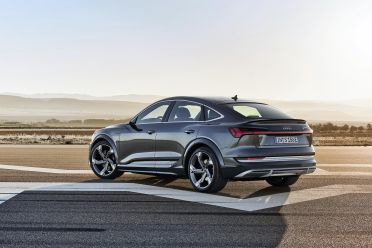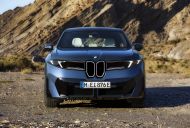Pay more, get less.
That’s been the ethos of coupe SUVs since the first-generation BMW X6 swaggered onto the scene. BMW took the mechanicals of an X5, gave it a swoopier and less practical body, and slapped on a higher price tag.
While many of us scoffed, it proved to be successful enough for BMW to keep around and even replicate in smaller form with the X4. It’s undoubtedly profitable too, considering how much of the X6 is shared with the less expensive X5.
After a while, Mercedes-Benz followed suit with its GLC Coupe and GLE Coupe. Much as the first Mercedes CLS started a trend towards four-door coupe passenger cars, the X6 has led to a plethora of coupe SUVs.
It’s a body style that’s always seemed pointless, but which might just have finally found a purpose. And that means it probably isn’t going anywhere anytime soon.
Volvo design boss Robin Page told Auto Express he’s pursuing sleeker, more coupe-like designs for future electric vehicles, as EVs and SUVs “contradict each other”.
“How does the world look when you have people wanting that high position and all the usability of an SUV, balanced with the fact they want range? Clean aerodynamics,” he said.
A sleeker body promises superior aerodynamics, which in turn means better efficiency. Just look at the Audi E-Tron – in flagship S trim, it has a drag coefficient of 0.28, compared to 0.26 in Sportback guise. That’s enough for the Sportback to eke out an extra 5km in electric range.
It wouldn’t be surprising, therefore, to see other EV manufacturers introduce coupe SUVs to balance the conflicting demand for high seating positions and maximum efficiency.
The same logic applies to internal combustion engine models. Automakers have already rolled out mild-hybrid and automatic stop/start technology, among other innovations, to keep emissions low and fuel economy high.
Offering more aerodynamic coupe crossover options could help satisfy SUV demand while also bringing down fleet average fuel economy, even if only incrementally.
In the meantime, plenty of automakers are rolling out coupe SUVs to satisfy demand and increase their margins.
Australia will get its first mainstream coupe SUV next year in the Renault Arkana, which shares its B0+ platform with the more conventionally-shaped Captur.
It won’t be the first sleek mainstream SUV offered here, however, as you could probably even apply the coupe SUV name to something like a Toyota C-HR which Toyota itself refers to as “Coupe High-Rider”.
Meanwhile in China, Volkswagen has introduced coupe versions of its mid-sized Tayron and full-sized Teramont (aka Atlas) SUVs, with a coupe version of the Tiguan on the way. The company’s Brazilian operations has also developed a coupe T-Cross, the Nivus, which it’ll export to Europe next year.
BMW might have invented the coupe SUV but Volkswagen has invested the most in democratising it, and it’s doubtful aerodynamics or efficiency is responsible. It’s tapping into a very receptive market.
China may have embraced sedans for longer than much of the world, but the world’s largest car market is falling hard for SUVs. Chinese consumers are also quickly flocking to coupe SUVs, even more so than those in other markets.
While coupe SUVs are typically found only in European luxury model ranges in other countries, mainstream Chinese brands such as Borgward, Changan, Dongfeng, Haval, Wey, and Zotye have all introduced coupe SUVs on the Chinese market over the past few years.
Volvo doesn’t have a coupe SUV yet but the Geely and Lynk & Co brands – also part of the Geely empire – have the Xingyue and 05, respectively, which share the Volvo XC40’s Compact Modular Architecture.
Many of these models won’t venture far from China, but it’s well within the realm of possibility another Asian or European brand will introduce a coupe SUV that’ll give buyers BMW X6 style at a more accessible price point.
It’s a logical move. As SUVs become increasingly ubiquitous, buyers may want to find a way to stand out in a sea of two-box, wagon-shaped vehicles.
While many of us would love to see those buyers migrate to something like, say, a station wagon, many of these buyers will no doubt be accustomed to a high-riding driving position. For many consumers, from those with car seats to those with canes, that’s a hard feature to give up.
I’m not here to defend the coupe SUV. Frankly, I preferred the four-door coupe trend that Mercedes-Benz kickstarted. It took me around a decade to finally come around to semi-liking the look of the first-generation X6, and I’m still not there yet with the X4, GLC Coupe and GLE Coupe.
When you think about it, though, “pay more, get less” has been the basic principle behind so many coupes over the years.
From humble Honda Civics to Mercedes-Benz S63 AMGs, automakers have been asking you for decades to pay a premium over a conventional sedan to have a little more style and panache, even if there’s a corresponding decrease in practicality and often no improvement in performance.
Now, these same companies are asking you to do the same but with an SUV. And many of you are happily doing it. Taste is subjective so, while I would never dream of paying at least $4000 more for an X6 over a comparable X5, someone else might want to.
While Volvo might be pursuing the body style in the interests of efficiency, others will continue to do so for profit. I might think they’re all ugly but what harm is a little extra variety?























